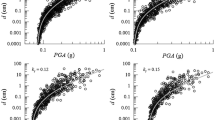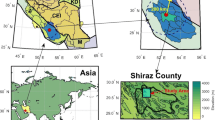Abstract
The 2004 Chuetsu earthquakes of Niigata (Japan) triggered numerous landslides, and the most widespread types of landslides were highly disrupted, relatively shallow slides and soil (debris) flows. This paper presented a method to evaluate slope instability using Newmark displacement on a pixel-by-pixel basis in a given area. The proposed method was able to integrate Newmark displacement modeling and Monte Carlo simulations within geographical information systems. In the modeling, an empirical attenuation relationship was utilized to calculate Arias intensity over this study area, and the variability of geotechnical parameters was taken into account to calculate coseismic landslide displacement. Before deriving the displacement from related inputs, the Monte Carlo simulations ran 1,500 times and generated 1,500 displacement values for each grid cell, and then means and standard deviations of displacement were calculated and probabilistic distributions can be obtained. Finally, given 10 cm as a threshold value of displacement, estimated probabilities of displacement exceeding 10 cm were shown as a map of seismic landslide hazards. The resulting hazard map was classified into four categories from very low to high level.





Similar content being viewed by others
References
Ambraseys NN, Menu JM (1988) Earthquake-induced ground displacements. Earthq Eng Struct Dyn 16:985–1006
Arias A (1970) A measure of earthquake intensity. In: Hansen RJ (ed) Seismic design for nuclear power plants. Massachusetts Institute of Technology Press, Cambridge, pp 438–483
Capolongo D, Refice A, Mankelow J (2002) Evaluating earthquake-triggered landslide hazard at the basin scale through GIS in the Upper Sele River valley. Surv Geophys 23:595–625
Carro M, De Amicis M, Luzi L, Marzorati S (2000) The application of predictive modeling techniques to landslides induced by earthquake: the case study of the 26 September 1997 Umbria-Marche earthquake (Italy). Eng Geol 69:139–159
Chigira M (1982) Dry debris flow of pyroclastic fall deposits triggered by the 1978 Izu-Oshima-Kinkai earthquake: the collapsing landslide at Nanamawari, Mitaka-Iriya, southern Izu Peninsula. J Nat Disaster Sci 4:1–32
Chigira M, Yagi H (2006) Geological and geomorphological characteristics of landslides triggered by the 2004 nid Niigata Prefecture earthquake in Japan. Eng Geol 82(4):202–221
Crespellani T, Madiai C, Vannucchi G (1998) Earthquake destructiveness potential factor and slope stability. Geotechnique 48(3):411–419
Del Gaudio V, Wasowski J (2004) Time probabilistic evaluation of seismically induced landslide hazard in Iripinia (Southern Italy). Soil Dyn Earthqu Eng 24(12):915–928
Earthquake Engineering Research Institute (EERI) Special Earthquake Report, January 2005. Preliminary observations on the Niigata Ken Chuetsu, Japan, earthquake of October 23, 2004. http://www.eeri.org/lfe/pdf/japan_niigata_eeri_preliminary_report.pdf
Fenton GA, Griffiths DV (2004) Closure to discussion on bearing capacity prediction of spatially random c–f soils. Can Geotech J 41(2):368–369
Geographical Survey Institute of Japan (GSI) (2004) Sheet map of the Chuetsu earthquake disaster in Niigata Prefecture, scale 1:30,000
Hirata N, Sato H, Sakai S, Kato A, Kurashimo E (2005) Fault system of the 2004 mid Niigata Prefecture earthquake and its aftershocks. Landslides 2:153–157
Hung JJ (2000) Chi-Chi earthquake induced landslides in Taiwan. Earthq Eng Eng Seismol 2(2):25–33
Inoue Y, Honsho S, Matsushima M, Esashi Y (1970) Geological and soil mechanical studies on the slides occurred during the 1968 Toakachioki earthquake in southeastern area of Aomori Prefecture. Report, vol. 69086. Central Research Institute of Electric Power Industry, pp 1–27
Jibson RW (2007) Regression models for estimating coseismic landslide displacement. Eng Geol 91:209–218
Jibson RW, Keefer DK (1993) Analysis of the seismic origin of landslides: examples from the New Madrid seismic zone. Geol Soc Amer Bull 105:521–536
Jibson RW, Harp EL, Michael JA (2000) A method for producing digital probabilistic seismic landslide hazard maps. Eng Geol 58:271–289
Lin ML, Tung CC (2003) A GIS-based potential analysis of landslides induced by the Chi-Chi earthquake. Eng Geol 71:63–77
Luzi L, Pergalani F (2000) A correlation between slope failures and accelerometric parameters: the 26 September 1997 earthquake (Umbria-Marche, Italy). Soil Dyn Earthqu Eng 20:301–313
Luzi L, Pergalani F, Terlien MTJ (2000) Slope vulnerability to earthquakes as subregional scale, using probabilistic techniques and geographic information systems. Eng Geol 58:313–336
Mankelow JM, Murphy W (1998) Using GIS in the probabilistic assessment of earthquake triggered landslide hazards. J Earthqu Eng 2(4):593–623
Mikami A, Sawada T (2005) Simultaneous identification of time and space variant dynamic soil properties during the 1995 Hyogoken-Nanbu earthquake. Soil Dyn Earthqu Eng 25:69–77
Miles SB, Ho CL (1999) Rigorous landslide hazard zonation using Newmark’s method and stochastic ground motion simulation. Soil Dyn Earthqu Eng 18:305–323
Miyagi T (2004) Inspection committee of the Japan Landslide Society, and Inspection committee of the APERIF, 2004. A report of the landslide disaster activated at Tsukidate Miyagi prefecture by the Sanriku-minami earthquake, 26 May, 2003. Journal of the Japan Landslide Society 40(2):45–46
Nadim F, Einstein H, Roberds W (2005) Probabilistic stability analysis for individual slopes in soil and rock. In: Hungr O, Fell R, Couture R, Eberhardt E (eds) Landslide risk management. London, Taylor & Francis Group, pp 63–98
National Research Institute of Earth Science and Disaster Prevention (NIED) (2004) The 2004 mid Niigata earthquake. Available online: http://www.hinet.bosai.go.jp/topics/niigata041023
Newmark NM (1965) Effects of earthquakes on dams and embankments. Geotechnique 15:139–160
Okuda S, Okunishi S, Suwa K, Yokoyama H, Yoshioka K (1984) Restoration of motion of debris avalanche at Mt. Ontake in 1984 and some discussions on its moving state. Annual Report of the Disaster Prevention Research Institute, Kyoto University, vol. 28, pp 491–504
Parise M, Jibson RW (2000) A seismic landslide susceptibility rating of geologic units based on analysis of characteristics of landslides triggered by the 17 January, 1994 Northridge, California earthquake. Eng Geol 58:251–270
Plafker G, Ericksen GE, Fernández CJ (1971) Geological aspects of the May 31, 1970, Peru earthquake. Seismological Society of America Bulletin 61:543–578
Research Group for Active Faults (1980) Active faults in Japan: sheet maps and inventories. University of Tokyo Press, Tokyo, pp 132–133
Sassa K, Hiroshi F, Wang FW, Wang GH (2005) Dynamic properties of earthquake-induced large-scale rapid landslides within past landslide masses. Landslides 2(2):125–134
Takeuchi K, Yanagisawa Y, Miyazaki J, Ozaki M (2004) 1:50,000 digital geological map of the Uonuma region, Niigata Prefecture, Geological Survey of Japan, Open-file Report No. 412
Travasarou T, Bray JD, Abrahamson NA (2003) Empirical attenuation relationship for Arias Intensity. Earthq Eng Struct Dyn 32:1133–1155
Wieczorek GF, Wilson RC, Harp EL (1985) Map showing slope stability during earthquakes in San Mateo County, California. Miscellaneous Investigation Maps I-1257-E, scale 1:62,500, USGS
Acknowledgments
The first author would like to acknowledge with thanks the postdoctoral fellowship for foreign researchers provided by the Japan Society for the Promotion of Science (JSPS). The research was partially carried out with the financial support from the National Natural Science Foundation of China (Project No. 50539110 and 40772170), and Ministry of Science and Technology of China (No. 2006BAC04B05). This work was also supported by Program for Talents in Huazhong University of Science and Technology.
Author information
Authors and Affiliations
Corresponding author
Rights and permissions
About this article
Cite this article
Wang, H., Wang, G., Wang, F. et al. Probabilistic modeling of seismically triggered landslides using Monte Carlo simulations. Landslides 5, 387–395 (2008). https://doi.org/10.1007/s10346-008-0131-6
Received:
Accepted:
Published:
Issue Date:
DOI: https://doi.org/10.1007/s10346-008-0131-6




